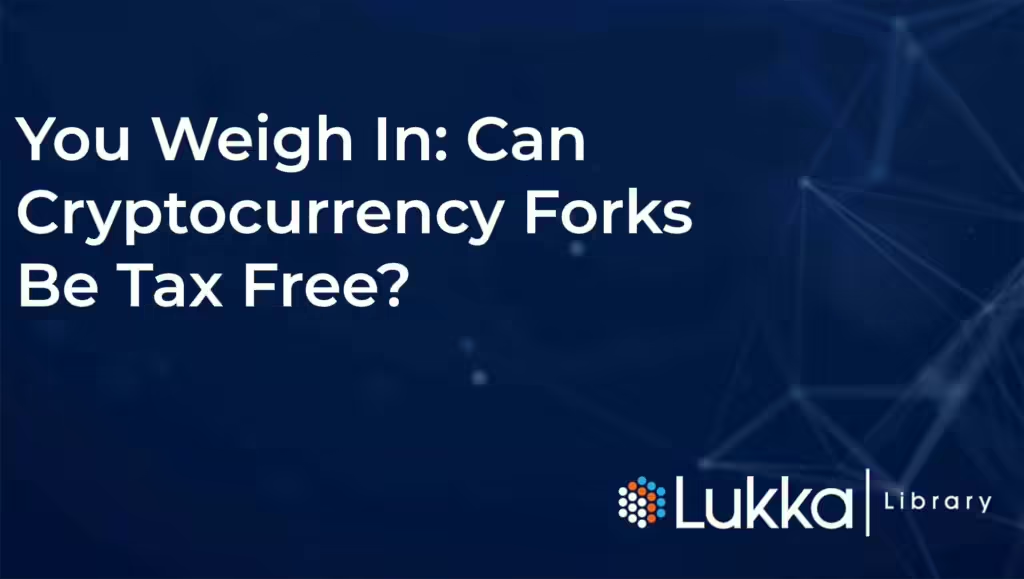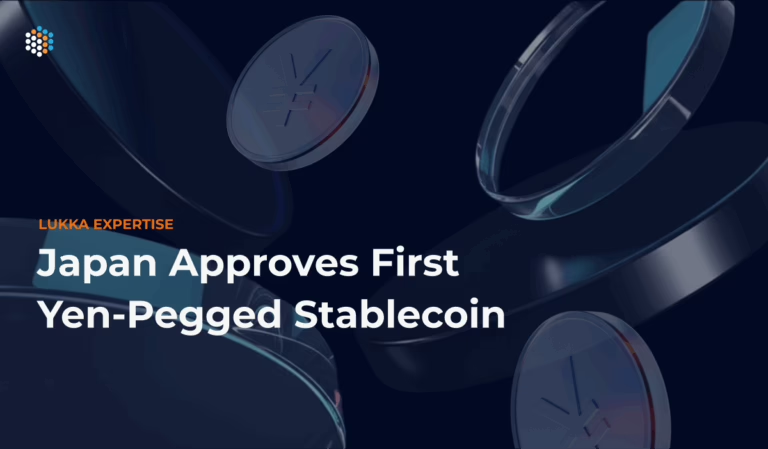Published by Taxnotes Federal
Author: Benjamin M. Willis
Volume 166, Number 9 March 2, 2020
Reprinted from Tax Notes Federal, March 2, 2020, p. 1469
I decided to try explaining tax to my son through tax-free cryptocurrency forks. He is a toddler. But we all must start somewhere, right?
My son had a dime. I said, “Son, if you hold onto this you will get nickels in the future, dividends of sorts. Those additional nickels are taxable money.”
However, if you find your dime has become two nickels, that is tax free. He asked, “Like magic?” Precisely, I responded.
He counted the nickels and dimes on his chart and said, “I have more with a nickel and a dime and the same with two nickels.” That’s why getting two nickels for your dime is tax free: You have no more than you previously had. It’s just a little different. Welcome to tax, son.
Dividing Mediums of Exchange
When property fluctuates in value, when it increases or decreases, tax is not generally incurred until a later event occurs that fixes the realization of the then current value. Consider fiat currencies, marketed securities, and publicly traded partnership interests. Value changes can occur in less than a second. But tax is logical and administrable — usually.
Commodities like dimes, trees, oil, water, gold, and land can be separated. These separations fail to result in an accession to wealth or realization of any change in value.
Realization of an accession to wealth occurs when ownership rights to property have changed. An increase in value could be like the lengthening of a virtual blockchain — like steps, or an algorithm, taken to lengthen a virtual train by one rail car.
Value can grow just like a tree. Even an increase in a dime’s buying power relative to other fungible assets can increase wealth. Commodities and fungible assets, like virtual currency or tokens, are all mediums of exchange that can grow in value, just like a tree.
Rev. Rul. 2019-24
Situation 1 presents no issue at all since it states within the issue, found in the first sentence of the ruling, “if the taxpayer does not receive units of a new cryptocurrency.” Of course, the holding for this situation is there is no taxable income: The taxpayer received nothing. That portion of the ruling is meaningless because they address the basic concept of receipt, which is based on dominion and control, in the second situation.
Situation 2 of Rev. Rul. 2019-24, 2019-44 IRB 1004, states these facts:
B holds 50 units of Crypto R, a cryptocurrency. On Date 2, the distributed ledger for Crypto R experiences a hard fork, resulting in the creation of Crypto S. On that date, 25 units of Crypto S are airdropped to B’s distributed ledger address and B has the ability to dispose of Crypto S immediately following the airdrop. B now holds 50 units of Crypto R and 25 units of Crypto S. The airdrop of Crypto S is recorded on the distributed ledger on Date 2 at Time 1 and, at that date and time, the fair market value of B’s 25 units of Crypto S is $50. B receives the Crypto S solely because B owns Crypto R at the time of the hard fork. After the airdrop, transactions involving Crypto S are recorded on the new distributed ledger and transactions involving Crypto R continue to be recorded on the legacy distributed ledger.1
The ruling goes on to explain that under section 61, “undeniable accessions to wealth, clearly realized, over which a taxpayer has complete dominion, are included in gross income.” Under the ruling, B includes in gross income, and has a basis of, $50, the FMV of B’s 25 units of Crypto S when the airdrop is recorded on the distributed ledger.
Some believe cryptocurrency forks result in an accession to wealth.2 I disagree and believe they can be tax-free. Because “B receives the Crypto S solely because B owns Crypto R at the time of the hard fork” and “the FMV of B’s 25 units of Crypto S is $50,” it is possible that B’s 50 units of Crypto R decreased in value by $50, as can be the case with a nontaxable stock split governed by sections 305 and 307.
While section 305 is based on the Supreme Court’s decision in Eisner v. Macomber,3 the case is about an accession to wealth of any property that has “been split up in effect and [has] diminished in value to the extent of the value of the new.”4 This is common for many commodities and nearly any medium of exchange. However, for a stock dividend or a return of capital, under the principles of Eisner v. Macomber, the distribution is viewed as akin to a return of capital and not as a return on capital; the former is a capital transaction and the latter is an income transaction.
The Supreme Court decided Eisner v. Macomber under the Revenue Act of 19165 and explained:
A stock dividend really takes nothing from the property of the corporation, and adds nothing to the interests of the shareholders. Its property is not diminished, and their interests are not increased.
The proportional interest of each shareholder remains the same. The only change is in the evidence which represents that interest, the new shares and the original shares together representing the same proportional interest that the original shares represented before the issue of the new ones. In short, the corporation is no poorer and the stockholder is no richer than they were before. . . . What has happened is that the plaintiff’s old certificates have been split up in effect and have diminished in value to the extent of the value of the new.6
The following year, section 201 of the Revenue Act of 1921 was updated to omit the taxation of stock dividends generally based on Eisner v.Macomber.7
Virtual currency has been defined by the IRS since its first public guidance in 2014 as “any digital representation of value that — (i) functions as a medium of exchange, a unit of account, or a store of value, (ii) does not have legal tender status, and (iii) has an ascertainable equivalent value in legal tender or is used as a substitute for legal tender.”8
Are we to believe that a commodity cannot be equitably apportioned such that the relative values of the divided properties are collectively the same and, thus, that there has been no accession to wealth? Do you think cryptographers cannot divide value economically in the same way timber can be divided and sold or deemed sold under section 631?9 Similar tax-free separation principles have applied to various commodities such as oil and gas under the pool of capital theory.
In Palmer,10 the Supreme Court considered whether the owner of an overriding royalty from a producing well was entitled to the depletion allowance under section 214(a)(10) of the Revenue Act of 1921. The Court held that the statute did not confine the depletion allowance to those who had a “particular form of legal interest in the mineral content of the land.” The Court’s rationale was that the interest holder was not looking to the other parties to the contract for a return on his investment, but to the anticipated production from the reservoir. The Court explained: “Throughout their changing relationships with respect to the properties, the oil in the ground was a reservoir of capital investment of the several parties, all of whom . . . were entitled to share in the oil produced.” Palmer introduced the nonrealization of income concept regarding sharing arrangements.11 And why should such additions to a pool of capital investment to share in future growth constitute a taxable event until that growth is accessible, if not until sold?
Also, in Laster,12 the court found that drilling cost payments in return for oil payments constitute a tax-free investment. In Transcalifornia,13 the court determined cash received to be used in drilling a well was an investment in oil and was not taxable to transferors as a sale. These principles on accessions to wealth are found throughout tax law, as we’ll continue to explore.
Like-Kind Exchanges, Corporate Nonrecognition
One reason stock and securities are often looked to for analogous authority on tax-free cryptocurrency transfers has nothing to do with both often being fungible mediums of exchange. It has to do with both like-kind exchanges and tax-free exchanges of stock being created by Congress through the Revenue Act of 1921,14 which incorporated the principles of Eisner v. Macomber and was intended to allow for the tax-free continuation of property that has taken on a new form but provide for continuity of ownership. In short, did they cash out under current sections 305, 351, 355, 368, and 1031? If so, you have an accession to wealth. If not, you generally have no taxable income.
In 1921 like-kind and corporate reorganizations were excluded from gain recognition for the same reason.15 Some taxpayers relied on section 1031 for like-kind exchanges of cryptocurrencies before the Tax Cuts and Jobs Act, which stopped that provision from applying to like-kind business or investment assets — with the exclusion of real estate.
The Senate report described the purpose of these predecessors to current sections 368, 351, and 1031 as follows:
Section 202 (subdivision c) provides new rules for those exchanges or “trades” in which, although a technical “gain” may be realized under the present law, the taxpayer actually realizes no cash profit. Under existing law “when property is exchanged for other property, the property received in exchange shall, for the purpose of determining gain or loss, be treated as the equivalent of cash to the amount of its fair market value, if any.
The existing law makes a presumption in favor of taxation.
The proposed act modifies that presumption by providing that in the case of an exchange of property for property no gain or loss shall be recognized unless the property received in exchange has a readily realizable market value, and specifies in addition certain classes of exchanges on which no gain or loss is recognized even if the property received in exchange has a readily realizable market value. These classes comprise the cases where productive property (other than stock in trade or property held primarily for sale) used in a trade or business is exchanged for property of a like kind or use; where in any corporate reorganization or readjustment stock or securities are exchanged for stock or securities of a corporation which is a party to or results from such reorganization; and where an individual or individuals transfer property to a corporation and after such transfer are in control of such corporation. The preceding amendments, if adopted, will, by removing a source of grave uncertainty and by eliminating many technical constructions which are economically unsound, not only permit business to go forward with the readjustments required by existing conditions.16[Emphasis added.]
Realization
Without addressing the values of both cryptocurrencies and any difference in legal entitlements provided by the fork, the IRS provides no justification for taxation in Rev. Rul. 2019-24.
In Weiss v. Stearn,17 the Supreme Court considered the formation of a new corporation that was organized under the laws of the same state as its predecessor and took all assets and business in a purported tax-free reorganization. The Court held that the stockholders of the successor corporation realized taxable gain only on the shares of the new corporation they sold, and the remaining stock that they exchanged for stock in the new corporation was not subject to taxation because there was no realization.
The Court explained: “We cannot conclude that mere change for purposes of reorganization in the technical ownership of an enterprise, under circumstances like those here disclosed, followed by the issuance of new certificates constitutes gain separated from the original capital interest. Something more is necessary — something which gives the stockholder a thing really different from what he theretofore had.” The IRS cited Weiss v. Stearn, for nonrealization in what some thought was an F reorganization in LTR 201026010.
In Cottage Savings the Supreme Court held that the taxpayer’s exchange of one bundle of mortgages for a very similar bundle of mortgages (but with different underlying property) was truly a change in the taxpayer’s economic position, and thus permitted the taxpayer’s loss deduction.18 The commissioner had argued that the exchange was not a true “disposition” for section 1001 purposes because economically there was no change in the portfolios held before and after the exchange. The commissioner even pointed out that the applicable accounting standards did not require an accounting loss because the exchanged properties were “substantially identical.” The Court, however, held in favor of the taxpayer and stated that the“material difference” standard in section 1001 is met as long as the properties consist of legally distinct entitlements. In Cottage Savings, this test was met because the mortgages represented different properties and obligors.
In Avery, 19 in which a subdivision of a tract of land was not a realization event, the court explained that the timing of gain occurred upon disposition of the property:
The fact, however, that the property was acquired in 1917 in one tract, does not mean that the entire tract must be disposed of before a determination of gain or loss may be made on the portions thereof which have been sold or disposed of. Property may be acquired in one tract, divided and sold in several tracts, and, in our opinion, it is not necessary to wait until all of the tract is disposed of before gain or loss may be determined with respect to the subdivided tracts. The purchase price of the entire tract may be allocated to the portions or subdivided tracts that are sold and gain or loss determined.20
Conclusion
I am arguing for tax-free cryptocurrency transactions and modified the facts of Rev. Rul. 2019-24 slightly (a reduction in the value of Crypto R by $50 and the issuance of Crypto S with similar legal entitlements) to show how a fork may not result in an accession to wealth. After all, the established case law and statutory authorities noted above clearly say that if the taxpayer is not in a better economic position after the fork, but either has the same net value or a lesser amount, there is no realization. The revenue ruling omits any discussion of the value of the legacy currency after the fork. Was this intentional? Was it intentional not to discuss whether the taxpayer had merely made a “bargain purchase” or that it was a gift under Duberstein?21By clarifying the fact that B’s net value in its cryptocurrency did not change, we can now understand why these were not cited; however, we still cannot understand the IRS’s conclusion on an accession to wealth. The facts simply don’t support this conclusion, and the facts modified above show how easily designers of cryptocurrency can create a tax-free hard fork.
I won’t discuss in this article the other theories that commentators have relied on for nontaxation until the currency is sold, which primarily involve an analogy to a painter not having gross income before the sale of a painting as has often been pointed out. I am also not the only commentator who views a hard fork as potentially involving no realization.22
Subdivisions of land are rather simple when you get right down to it. Basically, land is “subdivided” when it is broken up into smaller parcels.23 The same is true for forks, and the benefits can occur for various reasons. To think that cryptographers and those well versed in virtual currency transactions cannot fall within the large body of law governing tax-free transactions is naive.
Perhaps the IRS did not provide the value of B’s 50 units and whether the legal entitlements were changed — as opposed to the mere division of property — because they knew that those facts could result in a tax-free hard fork. By failing to provide these facts, the holding merely confirms the rights and values did change and these basic yet critical facts were excluded from the ruling soas to not lay out an instruction manual for tax-free cryptocurrency separations. See, if the IRS failed to understand the tax-free substantial alterations of tokens, theyʹd fail to understand that the alterations caused by Bitcoin halvings and divisions of mediums of exchange are generally tax-free. For taxpayers, all that is needed is proper valuations and/or knowledge that divided units have similar legal entitlements. This ruling is known to stem from the Bitcoin Cash split. But by looking at the flip side of the coin, one can see how the future design of hard forks will determine their treatment as tax-free. Cryptocurrency designers can greatly affect the initial price of tokens, including through mining complexity, rewards, and initial purchases.
But, then again, maybe two nickels don’t equal a dime.
1 Rev. Rul. 2019-24.
2 David J. Shakow, “Taxing Bitcoin and Blockchains: What the IRS Told Us (and Didn’t),” Tax Notes Federal, Jan. 13, 2020, p. 241; see also memorandum by Monte A. Jackel to IRS Chief Counsel Michael J. Desmond (Oct. 15, 2019).
3 Eisner v. Macomber, 252 U.S. 189 (1920).
4 Id. (internal citations omitted).
5 39 Stat. 756. See also Tax Analysts, “The Income Tax Arrives.”
6 Eisner v. Macomber, 252 U.S. 189 (internal citations omitted).
7 See S. Rept. 67-275 (“Section 201 clarifies the definition of dividends as contained in the revenue act of 1918, by omitting or exempting stock dividends as required by the decision of the Supreme Court in Eisner v. Macomber (252 U.S. 189).”).
9 Notice 2014-21, 2014-16 IRB 938.
10 See section 631(a) (providing a taxpayer election to treat the cutting of timber as a sale or exchange of such timber); see also Nelson C. Yates II, “Stock or Livestock? Hard Fork Basis Allocation,” Tax Notes, Jan. 7, 2019, p. 61.10Palmer v. Bender, 287 U.S. 551 (1933).
11 See, e.g., Burke, “How Should an Economic Interest Acquired for Services Be Treated After Rev. Rul. 83-46?” 58 J. Tax’n 352 (1983).
12 Laster v. Commissioner, 43 B.T.A. 159 (1940).
13 Transcalifornia Oil Co. v. Commissioner, 37 B.T.A. 119 (1938).
14 Revenue Act of 1921, 42 Stat. 227.
15 Revenue Act of 1918, 40 Stat. 1060. While the 1918 act did not define reorganization, merger, or consolidation, these were carved out from the general rule of recognition.
16 See S. Rept. 67-275.
17 Weiss v. Stearn, 265 U.S. 242 (1924).
18 Cottage Savings Association v. Commissioner, 499 U.S. 554, 566-567 (1991).
19 Avery v. Commissioner, 11 B.T.A. 958 (1928).
20 See also Rev. Rul. 67-309, 1967-2 C.B. 263, which discusses the basis to be used in determining gain or loss upon the sale of an undivided one- half interest in real property, and the holding period thereof, when the taxpayer who owns an undivided one-half interest in the property, purchases the other undivided one-half interest, and subsequently sells an undivided one-half interest.
21 Under Commissioner v. Duberstein, 363 U.S. 278 (1960), if the distribution had been because of a gift for income tax purposes factually arising from “detached and disinterested generosity,” then wouldn’t that have been a nontaxable gift under section 102 and not gross income under section 61?
22 Arvind Ravichandran and Maurio A. Fiore, “Cryptocurrency Forks: A Response to the IRS’s Recent Guidance,” Tax Notes Federal, Feb. 24, 2020, p. 1261.
23 Reg. section 1.61-6(a) states the general principle applicable here: “When a part of larger property is sold, the cost or other basis of the entire property shall be equitably apportioned among the several parts, and the gain realized or loss sustained on the part of the entire property sold is the difference between the selling price and the cost or other basis allocated to such part.”



